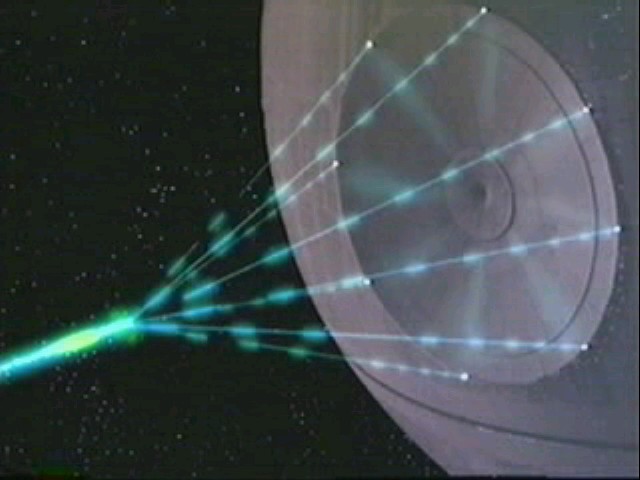Pentagon Eyeing Weapons In Space

The Pentagon is asking Congress for hundreds of millions of dollars to test weapons in space, marking the biggest step toward creating a space battlefield since President Reagan's long-defunct "star wars" project during the Cold War, according to federal budget documents.
The Defense Department's budget proposal for the fiscal year beginning Oct. 1 includes money for a variety of tests on offensive and defensive weapons, including a missile launched at a small satellite in orbit, testing a small space vehicle that could disperse weapons while traveling at 20 times the speed of sound, and determining whether high-powered ground-based lasers can effectively destroy enemy satellites.
The military says that its aerospace technology, which has advanced exponentially during the last two decades, is worth the nine-figure investment because it will have civilian applications as well, such as refueling or retrieving disabled satellites. But arms-control specialists fear the tests will push the military closer to basing weapons in space than during Reagan's Strategic Defense Initiative in the mid-1980s without a public debate of the potential consequences.
"Some of these things are going to be put up and tested and that is where you have the potential to cross the line" into creating actual space-based weapons systems, said Theresa Hitchens, director of the Center for Defense Information in Washington and coauthor of a new analysis on space weap ons spending.
Daryl Kimball, executive director of the Arms Control Association, warned that any US move to position weapons in space "will lead countries to pursue countermeasures. Before we cross that threshold, the United States should explore with other countries some guidelines or limits on what is deployed in space."
Excellent article on the weaponization of space...excerpt below:
Rumsfeld’s transformation in U.S. military space policy is driven by worst-case assumptions that the weaponization of space is inevitable; that conflict follows commerce in space, as on the ground; and that the United States must not wait to suffer a “Space Pearl Harbor.” Yet, the countries most capable of developing such weapons, such as Russia and China, have professed strong interest in avoiding the weaponization of space. The Bush administration has refused negotiations on this subject.
Link to a 2000, paper by (then Major) Michael J. Moran, discussing the need for force application from space. Force application is defined as: the use of space-based weapons to achieve specific effects as required by a combatant commander. Now, Lt. Col. Michael Moran, commands the 22nd Space Operations Squadron, 50th Operations Group, 50th Space Wing, which is located at Schriever Air Force Base, CO.
Here is a brief pdf of the major international space treaties that space-based weaponization would violate.
Article IV of the The 1967 Outer Space Treaty (which was signed by the US and is still in effect) states:
States Parties to the Treaty undertake not to place in orbit around the earth any objects carrying nuclear weapons or any other kinds of weapons of mass destruction, install such weapons on celestial bodies, or station such weapons in outer space in any other manner.
Strong and almost unanimous opposition to weaponization of space has been expressed in the United Nations Conference on Disarmament. China and Russia have drafted text for a treaty to ban space weapons. The United States, however, has refused to enter negotiations on such a treaty.
It is likely that the weaponization of space will begin in the foreseeable future unless it is hindered by organized, effective international opposition or the current US administration is replaced by an administration willing to cancel projects for weaponization of space in the face of considerable opposition from domestic proponents of weaponization.
Comprehensive resource on space policy and law


0 Comments:
Post a Comment
<< Home